After buying an inflatable boat, you need to get it to the water of course.
How you will transport your inflatable will depend mainly on the type and size of your boat, and your car.
Contents
How hard is it to transport your inflatable boat to the water?
People with traditional boats have it tough. They either need to rent a dock, or have a trailer and winch ready to put the boat onto water.
Inflatable boats are much simpler to transport than bulky traditional boats. If you have a car, boating with an inflatable is literally just a drive away.
But what is the best way to transport your inflatable dinghy or pontoon?
Let’s have a look at several methods.
Deflated transport
This is the most obvious, but the least hassle-free way to get your boat from A to B.

In the trunk
If you have a large car, your trunk will look like this.
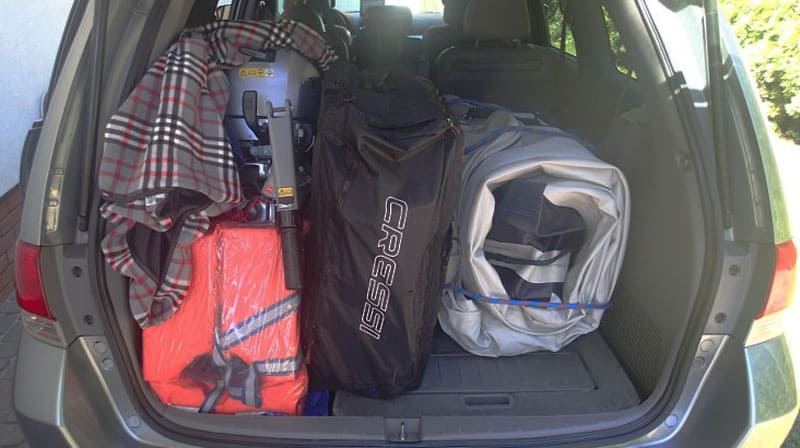
On a hitch
If you have a smaller car and need to deflate your boat, you might consider getting a hitch. They are reliable and work great in increasing your trunk space, but are a bit of a pain to set up and get used to driving with.
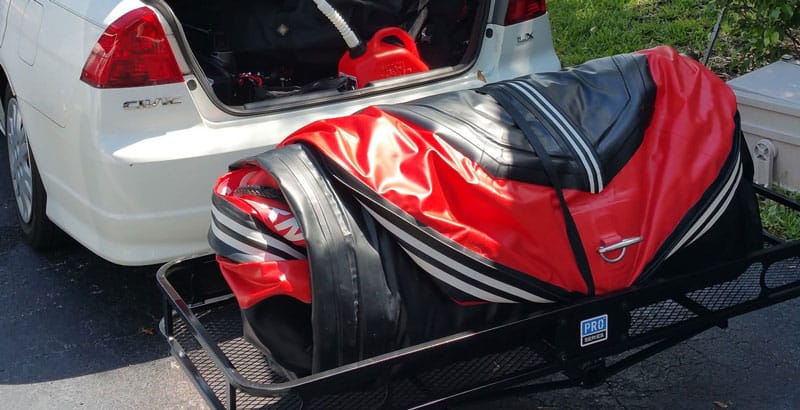
In a roof bag
If you are low on trunk space, I think the best option is getting a RoofBag, check it out here.
“What is a roof bag”, you say? It’s basically a bag that you can strap onto the roof of any car, even if you don’t have a roof rack. It is waterproof and very strong, making it perfect for transporting your deflated inflatable boat.
This is a very popular option, I have one and it is great. Check out what other customers think about it on Amazon.
Whichever way you go, the deflated transport of your boat involves the following.
- Completely deflate and disassemble your boat
- Pack it all up
- Put everything into your car (without leaving anything at home)
- Re-assemble it when you get to the water
If you have a simple inflatable raft without a hard floor, this is the best way to go.
TIP: Cut the time of inflation down by 50% using a strong electric air pump.
I use the Outdoormaster Shark pump, it has been very reliable. Here is my review of it.
If you have an inflatable dinghy with a hard floor or a pontoon boat with a frame, assembling your boat and taking it apart after you are finished for the day can be time-consuming. A hassle you may not want to deal with when you just want to enjoy boating, or are tired after a day out on the water.
The options below may be better suited to boats requiring longer assembly.
Car roof rack
The second most common way to transport an inflatable boat is on your car’s roof rack.
This is more convenient than deflating your boat, especially if yours takes a long time to reassemble.
The only restriction to this method of transporting your boat is the size of your boat. It can’t be much larger than your car’s, as it becomes a safety hazard.
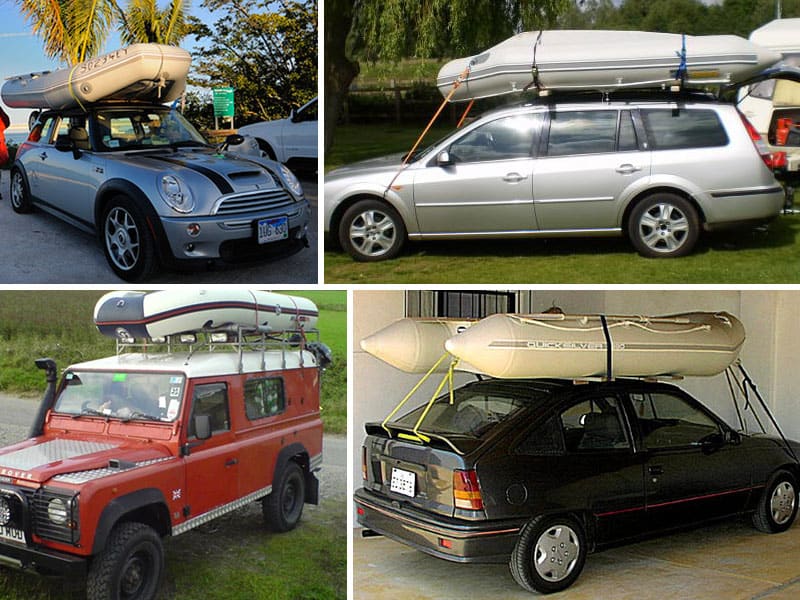
Here are the things you need to be mindful of when transporting your inflatable on your roof rack:
- Deflate the main tubes a bit before putting it on your roof, since the sun could cause it to over-inflate.
- Totally deflate the keel (if you have one), as you need the bottom of the boat to be flat.
- If you don’t have an actual roof rack and will just place the boat on your roof, it’s a good idea to put some kind of material onto your roof to protect your paint job.
- If it’s raining, it’s best to lay the boat upside-down, so it doesn’t fill with water. Otherwise don’t place it upside-down, as it will act as a parachute on your car.
- Don’t go too fast. In fact, don’t go fast at all. Stay around 45-50 MPH.
- Check your local traffic laws. There may be rules to what size/weight objects you can carry on your roof.
If you’re wondering exactly how to fix your boat to the car’s roof, here are the steps I take:
- I prefer to fix it right side up, so I deflate the keel
- Run a ratchet tie down strap (NOT a bungee chord) through the handle on one side -> over the boat -> through the handle on the other side
- Open the doors and run the strap through the door frames
- Fasten the strap in the car
- Do steps 1-4 in the rear doors as well for added safety
- Run another rope through the stern (back) handle down to the back of the car, tying it to your bumper or rear towing hook
- Run another strap through the bow (front) handle down to the front of the car, tying it to your bumper or front car towing hook.
A lot of air goes up your windscreen, so you need to make sure the front of the boat is fixed in place. It’s best to not have the nose of the boat hanging over the car’s roof.
TIP: If your boat is wider than your roof rack, you can place 2 pieces of wood across your roof rack towards the front and towards the back. This will provide support to the side tubes.
One more thing. You do not put anything into your boat on your roof while in transport. Place the fuel tank, engine and the rest of your gear in your car.
This might be evident to most people, but not all. I’ve actually seen a cooler being hauled in a boat on the roof rack. It was tied down seemingly well, but still. An accident waiting to happen.
Here are some suitable roof racks for your car on Amazon.
SUV cargo area
If you have a larger SUV and a not so large inflatable boat, here is a nice trick to get it to fit right into your vehicle.
- Lay your rear seats down flat
- Deflate the main tubes just enough, so that you can squeeze your boat into the rear area and still close the trunk door.
Needless to say, you can’t have people sitting in the rear seats if you transport your boat like this.
Pickup truck bed
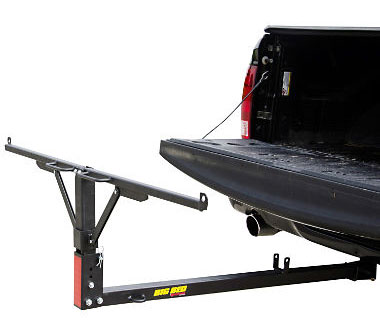
Transporting your inflatable boat is a breeze if you have a pickup truck, and if your boat fits into the truck bed.
TIP: If your boat is too long, here are some truck bed extenders that will solve the problem. Keep in mind that you need to place the heavier end of the boat into the truck bed first, so the lighter end is hanging out. Also, most traffic laws require hanging a red flag at the extended end of your cargo.
Of course, you will still have to tie the boat down firmly using ratchet tie downs. Here is how:
- Most trucks have hook attachments in the bed you can tie the width of the boat to. Run the strap through the boat handles
- Tie another strap to the step bumper or any area around the tailgate.
Having a pickup makes putting the boat onto the water easy as well since you can back up all the way to the water and slide the boat out.
Trailer
If you have somewhere to park it, the trailer is a very convenient way to haul your inflatable boat.
You can buy a trailer made specifically for boats, or convert a PWC (personal watercraft like a jet ski) trailer to fit your boat.
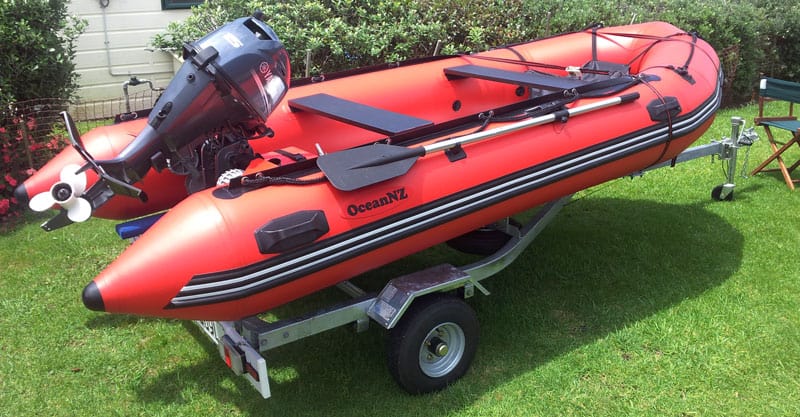
A trailer also makes launching your boat easier, if you can back it up to a ramp.
Here is an in-depth article I wrote about choosing trailers for inflatable boats.
Launch wheels make things much easier
Launch wheels are a godsend when it comes to hauling your boat from the car to the water.
Especially when you have extra gear, like a motor, cooler, batteries, etc.
Imagine never again having to go back and forth between your car and the water carrying your supplies to the boat. You can simply put everything into your boat by the car, and roll it all over to the water on sturdy wheels.
Really, they make life so much easier. I love them so much, I wrote a dedicated post on the ins and outs of launch wheels.
If you are ready to get yourself some launching wheels, there are 3 things you need to take into consideration:
- Weight rating of the wheels
- Size (bigger means easier pushing over bumps, but less room for your motor if you flip them upwards on the water)
- Will they fit
Launch wheels are designed to flip up and go along for the ride on the water, but you can take them off if they interfere with turning your engine when you turn.


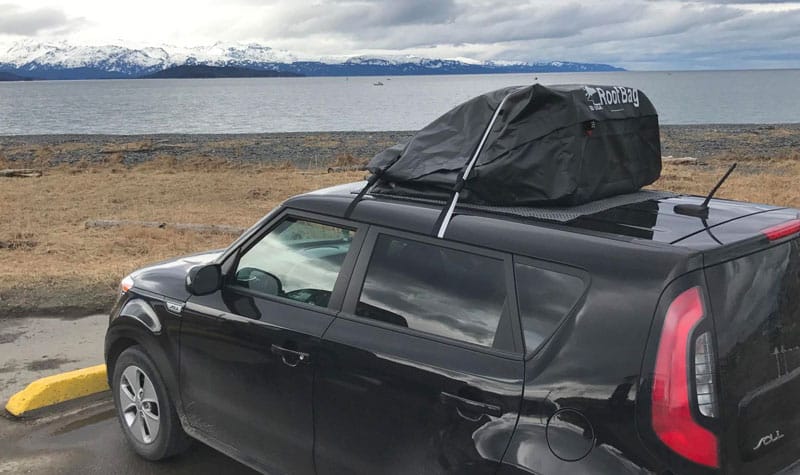
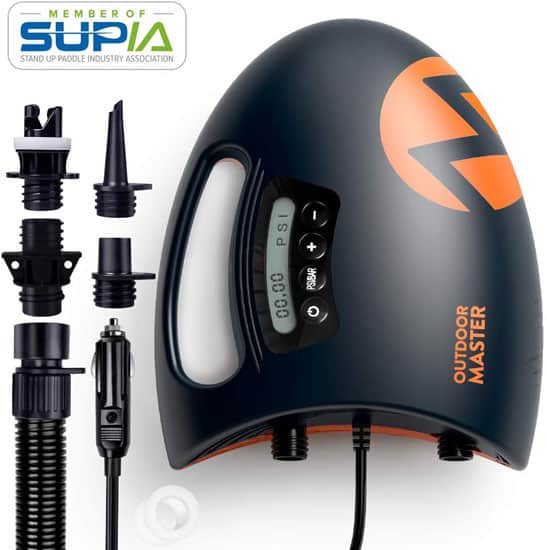
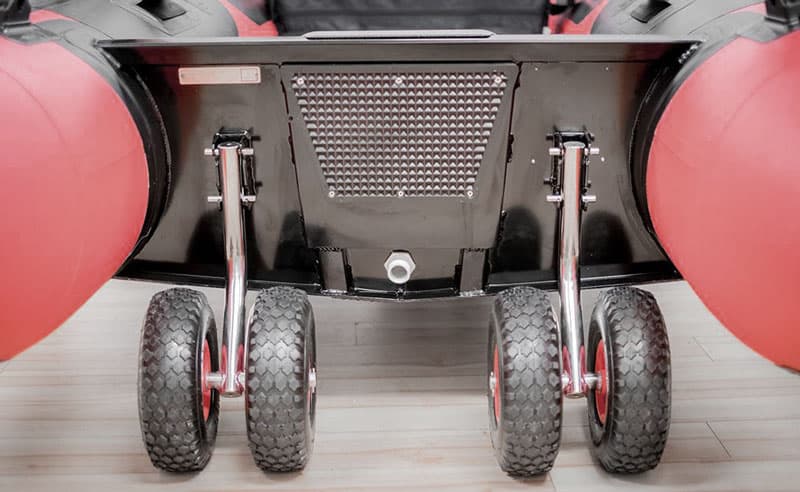
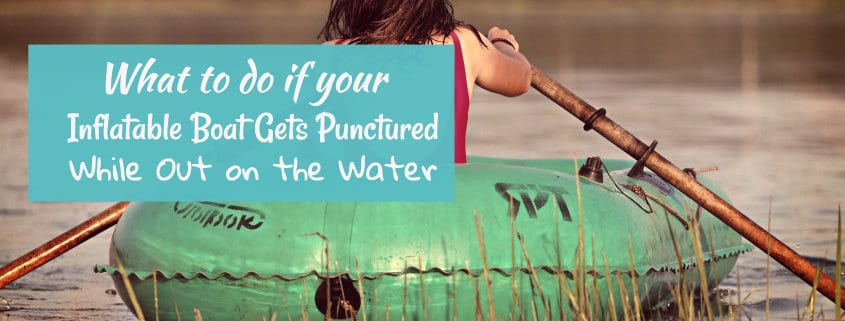
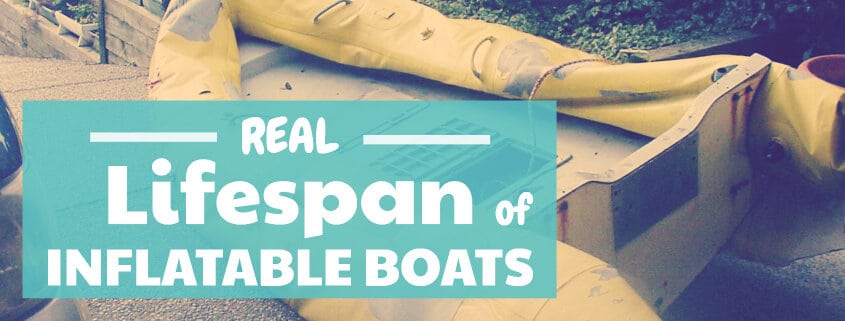
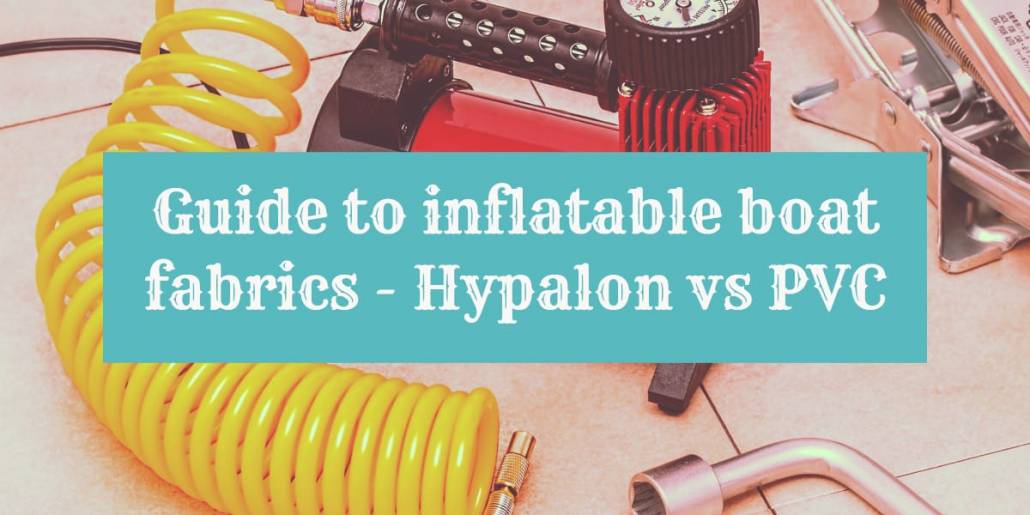
![[Guide] Inflatable Sports Boat Registration in All US States (2024 Update)](https://pumpupboats.com/wp-content/uploads/2019/02/A-guide-on-inflatable-sports-boat-registration-in-all-US-states.jpg)
Hi Dwight,
I was in the same situation as you.
until I bought a folding trailer. It is light, the weights range is between 35Kg – 80Kg – depends on the price and once it is folded, it doesn;t take much space.
I use my folding trailer now whenever I go to the water with my Hobie kayak or inflatable boat.
Hi Tom,
I have a bit of dileema when it comes to my inflatable boat. I have a 16ft Saturn SD488 inflatable boat and don’t know the best way to transport it to the water. I have a Honda Pilot and used to throw it deflated into the back of the vehicle (30 minutes), pump it up on location (50 minutes – the aluminum floor is a pain), and then deflate it and put it back in the vehicle (30 minutes).
After all that I realize, I realize I waste a lot of fishing time and I look like I ran a marathon. I live in a side by side house in the suburbs and don’t have enough room for a trailer.
I thought that your suggestion to put in on the roof would be great, but I am worried about it taking off like a kite or the aluminum floor coming loose. Is this something I should be worried about if I use heavy-duty straps? I bought a pack of 4 ratchet straps that are 2-3 inches wide and they are big! Should I deflate the keel and have it right side up?
If you have any other options I would love to hear them. I don’t have anybody to help me do anything and I am not getting any younger. Maybe I should work on getting a single-family house with a bigger driveway.
Thanks for your help!
Hi there, yes, taking the boat apart all the time is a pain.
You’re correct, deflate the keel and put it right side up onto your roof rack. That’s how I do it as well. You shouldn’t go too fast, keep it at max 45-50 MPH, and you won’t take off 🙂
That Saturn is gonna be heavy, you may need help getting it onto the roof…
Also, since the boat will hang over the windshield, you should have a strap running from your bow to the front bumper or tow hook. Otherwise, the front will be unstable.
Do you know where I can get launch wheels for my inflatable boat to run over soft sand. I have ballot wheels for my kayak trolley but can’t seem to find ballon wheels for the boat.
regarding the Launch wheels, how you do to connect it in the hitch of my car, is there any wheel going in the bow?
I’m not sure what you are asking. Please clarify in detail.